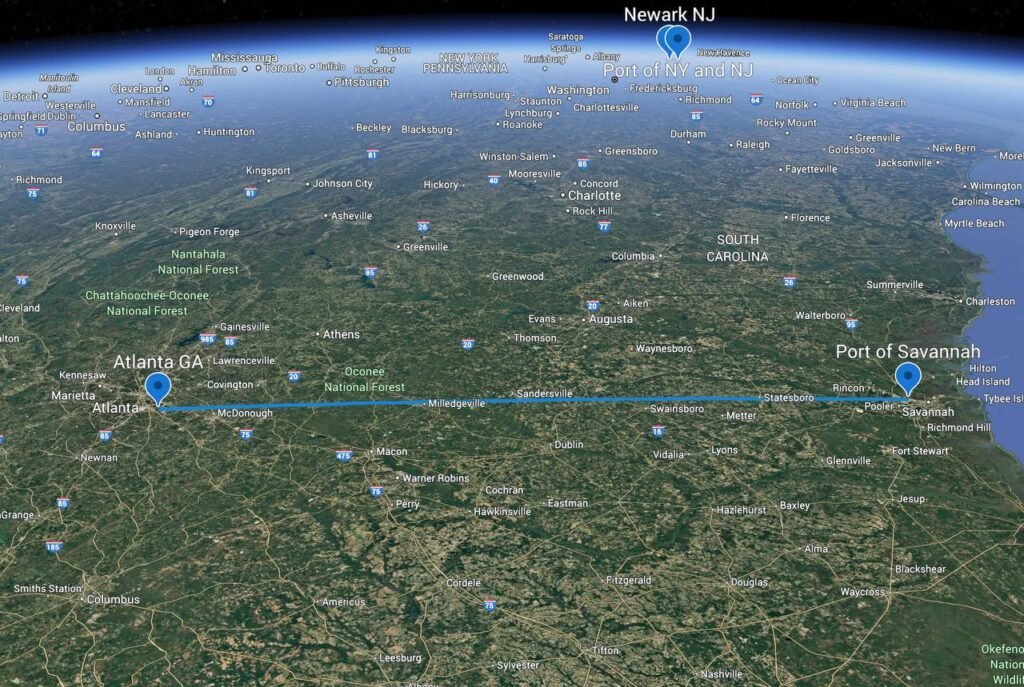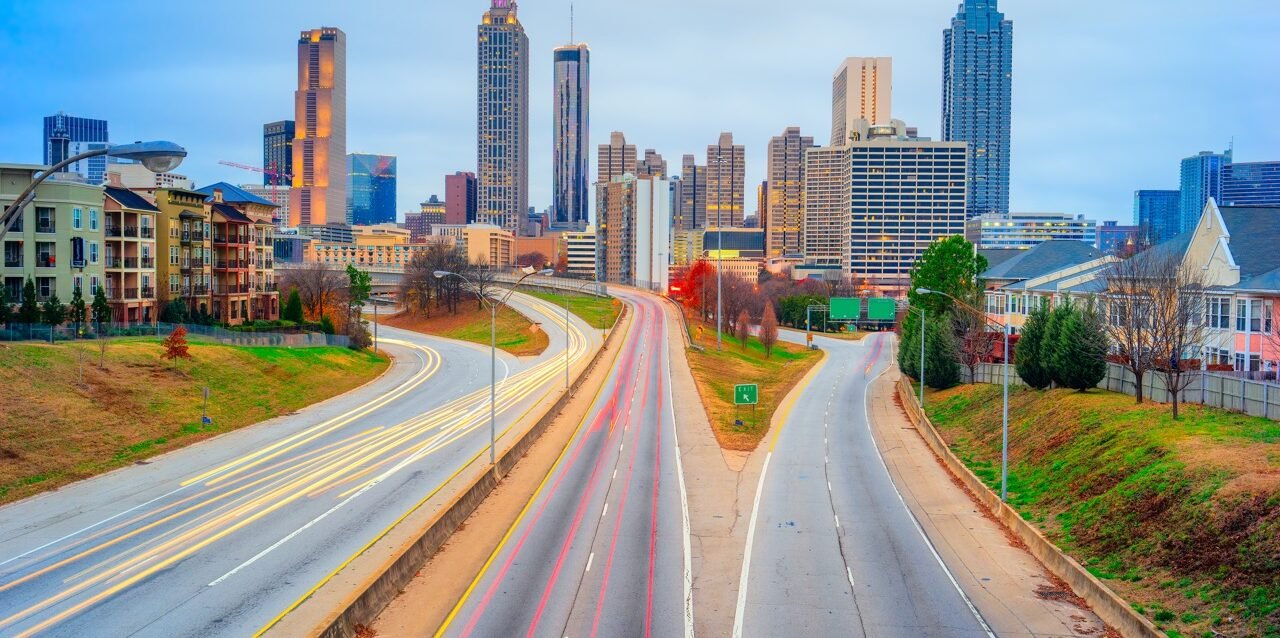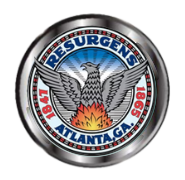Executive Summary
Atlanta, Georgia, stands at a crossroads: a projected surge of 1.8 million residents by 2050 threatens to overwhelm its already strained transportation infrastructure, amplifying inefficiencies in trucking, skyrocketing costs, and environmental degradation. Without bold action, this growth could burden the city’s economy with billions in lost productivity, heightened emissions, and social inequities, eroding quality of life and stifling Georgia’s Gross State Product (GSP). Yet, there’s immense hope on the horizon. By integrating the innovative American Dream Rail system—a high-speed, scalable passenger and freight network connecting the Port of Savannah to a new Atlanta distribution center—we can not only mitigate these challenges but catapult the city into a prosperous, sustainable era. This case study contrasts the dire “before” scenario of unchecked growth with the transformative “after” impacts of Dream Rail, projecting annual savings of over $139 million in freight costs alone, a 75% drop in emissions, and a new revenue stream via a 16% air-use tax delivering $44.5 million yearly to the city. Operational by 2035 and funded through the $5.5 trillion American Dream Rail legacy project, this solution promises to fly over congestion, slash truck traffic, and deliver efficiency that revives American industry. The urgency is clear: Atlanta must act now to secure a vibrant, connected future where growth fuels opportunity, not gridlock.

Introduction
Imagine Atlanta in 2050: a bustling metropolis of nearly 8 million people, its streets alive with energy—but choked by endless traffic jams, outdated roads, and a trucking sector buckling under inefficiency. As population swells, the movement of citizens and goods becomes a daily battle, draining wallets, time, and the environment. This isn’t just a local headache; it’s a national imperative. Georgia’s economic engine risks stalling if we don’t innovate. Enter the American Dream Rail system: a game-changing transportation lifeline that bypasses chaos, cuts costs, and restores efficiency. This case study urgently examines the before-and-after effects of Atlanta’s projected growth on transportation, highlighting the perils of inaction and the exhilarating benefits of embracing Dream Rail. With clarity and optimism, we’ll explore how this scalable solution—operating between the Port of Savannah and a new Atlanta distribution center 250 miles away—can turn projected burdens into boundless progress, ensuring a thriving city for generations.
Background Information
Atlanta’s rapid ascent as a Southern powerhouse is undeniable, but its transportation backbone is showing cracks. Currently, the 21-county metro region houses about 6.1 million residents, with the core 11-county area nearing 5.3 million. The Port of Savannah, a vital gateway, handled approximately 40.9 million short tons of cargo in fiscal year 2024, underscoring Georgia’s role in national trade. Yet, the trucking industry—plagued by driver shortages, fuel volatility, and empty hauls—remains inefficient, contributing to legendary congestion where drivers lose 53 hours annually, costing each $820–$1,200 in lost time.
Projections paint a pressing picture: The Atlanta Regional Commission (ARC) forecasts the region adding 1.8 million people by 2050, reaching 7.9 million—a 30% increase. This growth will intensify demands on obsolescent infrastructure, archaic systems, and an overburdened trucking sector. Georgia’s GSP, currently around $701 billion, could face headwinds from rising congestion costs, estimated at $3–$5 billion annually today and poised to escalate. Socially, inequities deepen as low-income communities bear the brunt of pollution and delays. The urgency is palpable: without intervention, growth becomes a curse, not a catalyst.
Problem or Challenge: The “Before” Scenario – Unchecked Growth’s Devastating Toll
Atlanta’s population boom by 2050 isn’t just numbers—it’s a ticking time bomb for transportation, economy, and society. Marginal growth of 1.8 million residents will amplify demands on roads, ports, and logistics, exposing the shameful inefficiencies of trucking (e.g., deadhead miles, driver shortages) and obsolete infrastructure. Here’s a breakdown of the long-term economic and social impacts, new needs, costs, shortfalls, and consequences:
○ New Essential Needs for the City and People:
- Expanded roadways and transit to handle 30–50% more daily trips, including freight from the Port of Savannah.
- Upgraded distribution hubs to process surging cargo volumes, preventing bottlenecks.
- Enhanced public transport and bike/ped networks to reduce car dependency amid congestion.
- Pollution mitigation measures, like electric vehicle incentives, to combat health risks from emissions.
○ Breakdown of Projected Costs to the City:
ARC’s long-range plan calls for $168 billion through 2050 in transportation investments—$100 billion for roads/highways, $40 billion for transit, and $28 billion for trails and safety.
Annual maintenance for aging infrastructure: $5–$7 billion, escalating with wear from increased truck traffic (projected 20–30% rise in heavy vehicles).
Freight-specific upgrades: $10–$15 billion for port extensions and inland logistics to manage 50 million+ short tons annually by 2050.
○ Cost to Individual Households:
Congestion alone could cost families $1,500–$2,000 yearly in lost time and fuel by 2050 (up from $1,200 today), assuming 70+ hours stuck in traffic.
Higher goods prices due to trucking inefficiencies: 10–15% inflation on essentials, adding $500–$800 per household annually.
Tax burdens for infrastructure: $300–$500 extra per year via sales/property taxes to fund the $168 billion plan.
○ Projected Shortfalls from Anticipated Limitations:
Funding gaps: Federal/state aid covers only 60–70% of needs, leaving $50–$60 billion unfunded amid budget constraints and political gridlock.
Capacity limits: Current roads handle 50 million daily vehicle miles; growth demands 70 million, but expansion is hampered by land scarcity and environmental regs.
Labor shortages: Trucking’s driver deficit (80,000 nationally) worsens, delaying deliveries and inflating costs by 20%.
○ Potential Consequences for Failing to Meet Shortfalls:
Economic stagnation: Lost productivity could shave 1–2% off Georgia’s GSP annually ($7–$14 billion), deterring business relocations.
Social fallout: Increased accidents (Atlanta’s roads already see 100,000+ crashes yearly), health issues from pollution (e.g., asthma spikes), and equity gaps as suburbs sprawl.
Environmental crisis: Emissions rise 25–40%, exacerbating climate vulnerabilities like heatwaves.
○ Effect on Gross State Product (GSP):
Growth could boost GSP to $900–$1 trillion by 2050, but congestion drags it down by $10–$20 billion yearly through reduced efficiency and investor flight.
○ Cost of Increased Emissions:
Freight trucking emits ~0.2 tons CO2 per short ton-mile; with 9.25 billion additional ton-miles from growth (based on 37 million tons baseline scaling 25%), that’s 1.85 million extra tons CO2 annually.
At $185 per ton (social cost of carbon), this adds $342 million in societal costs yearly—health, climate damages, and lost agriculture.
The challenge is urgent: inaction means a city paralyzed, economy eroded, and people suffering. But optimism abounds—solutions exist to flip this script.
Myron Manuirirangi
Solution or Approach: The American Dream Rail System – A Bold, Scalable Leap Forward
To counter this crisis, we propose the American Dream Rail: a revolutionary, elevated rail network linking the Port of Savannah to a new Atlanta distribution center, acting as a port extension. Operational at full capacity by 2035, it handles passengers and freight seamlessly, without disrupting city life or security. By relocating freight processing inland, it optimizes matching, management, and movement—cutting port dwell times and passing savings to U.S. industry.
Key benefits include:
Flyover Congestion: Elevated tracks bypass traffic, delays, detours, and closures.
Reduce Truck Traffic: Shifts 50% of freight (18.5 million short tons annually), slashing roadway trucks by millions.
Eliminate Accidents: Zero road interactions mean no crashes, saving lives and $billions in damages.
Cost Cuts: 50% reduction in transport expenses ($139 million annual savings on baseline freight costs).
Speed Gains: 50% faster deliveries (average 75 mph, vehicles 0.592 miles apart every 28.4 seconds).
Emission Reductions: 75% drop, curbing 1.39 million tons CO2 yearly (at $185/ton, $257 million societal savings)
This system captures 50% market share (daily 50,765 short tons) with 846 vehicles, generating revenue at $6 per 100-ton mile. A 16% air-use tax on gross revenue ($278 million annually) yields $44.5 million for Atlanta—funding needs without household hikes.
Compare/Contrast Before vs. After (With/Without Dream Rail):
- Costs: Before: $168 billion infrastructure burden; After: Offset by $44.5 million tax + $139 million industry savings (50% freight cost cut).
- Savings Differentials: Without: $342 million annual emission costs + $10–$20 billion GSP drag; With: 75% emission cut saves $257 million, boosts GSP 1–2% via efficiency ($7–$14 billion gain).
- Economic Impact: Before: $3–$5 billion congestion losses escalate; After: Reduces by 30–50% via fewer trucks, adding $1–$2 billion in productivity.
- Social Impact: Before: Health woes, inequities rise; After: Cleaner air, safer roads enhance quality of life, creating 5,000+ jobs in rail ops/distribution.
With Dream Rail, growth becomes a boon: efficient ports, thriving industry, and a resilient city.
Myron Manuirirangi
Implementation
Rolling out Dream Rail is feasible and funded. Capital costs—$8.75 billion for 250 miles of track ($35 million/mile) + $127 million for 846 vehicles ($150,000 each)—total $8.877 billion, covered by the $5.5 trillion legacy project. Construction phases: 2025–2030 planning/permits; 2030–2035 build-out. Operations ramp to full capacity by 2035, with daily volumes met via high-speed intervals.
Post-implementation “After” Impacts:
- Economic: GSP surges 2–3% ($14–$21 billion) from efficiency; households save $300–$500 yearly on goods/taxes.
- Social: Reduced congestion frees 20–30 hours per driver; emissions drop aids health, equity.
- Shortfalls Addressed: Tax revenue plugs $44.5 million gaps yearly; scalability handles further growth.
The path is clear: Implement now for a triumphant Atlanta by 2050.
#SignForAmericaLet’s make America unstoppable.
Sign the petition today for your sake, more so than President Trump’s.
Phone Numbers
Work: +1 (305) 000-0000
Support: +1 (888) 000-0000
Our Location
Work: +1 (305) 000-0000
Support: +1 (888) 000-0000
American Patriots, Inc., c/- dba: American Dream Rail Legacy Project
Miami FL, 33127
contact@AmericanDreamRail.com



